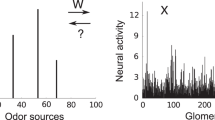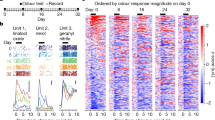Abstract
We present a neural algorithm for the rapid online learning and identification of odourant samples under noise, based on the architecture of the mammalian olfactory bulb and implemented on the Intel Loihi neuromorphic system. As with biological olfaction, the spike timing-based algorithm utilizes distributed, event-driven computations and rapid (one shot) online learning. Spike timing-dependent plasticity rules operate iteratively over sequential gamma-frequency packets to construct odour representations from the activity of chemosensor arrays mounted in a wind tunnel. Learned odourants then are reliably identified despite strong destructive interference. Noise resistance is further enhanced by neuromodulation and contextual priming. Lifelong learning capabilities are enabled by adult neurogenesis. The algorithm is applicable to any signal identification problem in which high-dimensional signals are embedded in unknown backgrounds.
This is a preview of subscription content, access via your institution
Access options
Access Nature and 54 other Nature Portfolio journals
Get Nature+, our best-value online-access subscription
$29.99 / 30 days
cancel any time
Subscribe to this journal
Receive 12 digital issues and online access to articles
$119.00 per year
only $9.92 per issue
Buy this article
- Purchase on SpringerLink
- Instant access to full article PDF
Prices may be subject to local taxes which are calculated during checkout






Similar content being viewed by others
Data availability
The Vergara et al. gas sensor dataset4 is freely available from the UCI Machine Learning database (http://archive.ics.uci.edu/ml/datasets/gas+sensor+arrays+in+open+sampling+settings).
Code availability
A software version of the model reproducing the primary results of Figs. 3–5 is freely available from the ModelDB public archive (http://modeldb.yale.edu/261864). The Loihi source code is freely available from Github (https://github.com/intel-nrc-ecosystem/models/tree/master/official/epl).
References
Davies, M. et al. Loihi: a neuromorphic manycore processor with on-chip learning. IEEE Micro 38, 82–99 (2018).
Rinberg, D., Koulakov, A. & Gelperin, A. Sparse odor coding in awake behaving mice. J. Neurosci. 26, 8857–8865 (2006).
Marco, S. & Gutierrez-Galvez, A. Signal and data processing for machine olfaction and chemical sensing: a review. IEEE Sens. J. 12, 3189–3214 (2012).
Vergara, A. et al. On the performance of gas sensor arrays in open sampling systems using inhibitory support vector machines. Sens. Actuat. B 185, 462–477 (2013).
Goff, S. A. & Klee, H. J. Plant volatile compounds: sensory cues for health and nutritional value? Science 311, 815–819 (2006).
Araneda, R. C., Kini, A. D. & Firestein, S. The molecular receptive range of an odorant receptor. Nat. Neurosci. 3, 1248–1255 (2000).
Araneda, R. C., Peterlin, Z., Zhang, X., Chesler, A. & Firestein, S. A pharmacological profile of the aldehyde receptor repertoire in rat olfactory epithelium. J. Physiol. 555, 743–756 (2004).
Rospars, J. P. Interactions of odorants with olfactory receptors and other preprocessing mechanisms: how complex and difficult to predict? Chem. Senses 38, 283–287 (2013).
Rospars, J. P., Lansky, P., Chaput, M. & Duchamp-Viret, P. Competitive and noncompetitive odorant interactions in the early neural coding of odorant mixtures. J. Neurosci. 28, 2659–2666 (2008).
Persaud, K. C, Marco, S. & Gutierrez-Galvez, A. Neuromorphic Olfaction (CRC Press, 2013).
Raman, B., Stopfer, M. & Semancik, S. Mimicking biological design and computing principles in artificial olfaction. ACS Chem. Neurosci. 2, 487–499 (2011).
Cleland, T. A. Construction of odor representations by olfactory bulb microcircuits. Prog. Brain Res. 208, 177–203 (2014).
Bathellier, B., Lagier, S., Faure, P. & Lledo, P. M. Circuit properties generating gamma oscillations in a network model of the olfactory bulb. J. Neurophysiol. 95, 2678–2691 (2006).
Li, G. & Cleland, T. A. A coupled-oscillator model of olfactory bulb gamma oscillations. PLoS Comput. Biol. 13, e1005760 (2017).
Peace, S. T. et al. Coherent olfactory bulb gamma oscillations arise from coupling independent columnar oscillators. Preprint at https://doi.org/10.1101/213827 (2018).
Kashiwadani, H., Sasaki, Y. F., Uchida, N. & Mori, K. Synchronized oscillatory discharges of mitral/tufted cells with different molecular receptive ranges in the rabbit olfactory bulb. J. Neurophysiol. 82, 1786–1792 (1999).
Linster, C. & Cleland, T. A. Decorrelation of odor representations via spike timing-dependent plasticity. Front. Comput. Neurosci. 4, 157 (2010).
Masquelier, T., Hugues, E., Deco, G. & Thorpe, S. J. Oscillations, phase-of-firing coding, and spike timing-dependent plasticity: an efficient learning scheme. J. Neurosci. 29, 13484–13493 (2009).
Banerjee, A. et al. An interglomerular circuit gates glomerular output and implements gain control in the mouse olfactory bulb. Neuron 87, 193–207 (2015).
Cleland, T. A., Johnson, B. A., Leon, M. & Linster, C. Relational representation in the olfactory system. Proc. Natl Acad. Sci. USA 104, 1953–1958 (2007).
Cleland, T. A. et al. Sequential mechanisms underlying concentration invariance in biological olfaction. Front. Neuroeng. 4, 21 (2012).
Miller, P. Itinerancy between attractor states in neural systems. Curr. Opin. Neurobiol. 40, 14–22 (2016).
Tong, M. T., Kim, T. P. & Cleland, T. A. Kinase activity in the olfactory bulb is required for odor memory consolidation. Learn. Mem. 25, 198–205 (2018).
Chu, M. W., Li, W. L. & Komiyama, T. Lack of pattern separation in sensory inputs to the olfactory bulb during perceptual learning. eNeuro 4, 5 (2017).
Doucette, W. & Restrepo, D. Profound context-dependent plasticity of mitral cell responses in olfactory bulb. PLoS Biol. 6, e258 (2008).
Sultan, S. et al. Learning-dependent neurogenesis in the olfactory bulb determines long-term olfactory memory. FASEB J. 24, 2355–2363 (2010).
Moreno, M. M. et al. Olfactory perceptual learning requires adult neurogenesis. Proc. Natl Acad. Sci. USA 106, 17980–17985 (2009).
Gao, Y. & Strowbridge, B. W. Long-term plasticity of excitatory inputs to granule cells in the rat olfactory bulb. Nat. Neurosci. 12, 731–733 (2009).
Lepousez, G. et al. Olfactory learning promotes input-specific synaptic plasticity in adult-born neurons. Proc. Natl Acad. Sci. USA 111, 13984–13989 (2014).
de Almeida, L., Idiart, M. & Linster, C. A model of cholinergic modulation in olfactory bulb and piriform cortex. J. Neurophysiol. 109, 1360–1377 (2013).
Devore, S. & Linster, C. Noradrenergic and cholinergic modulation of olfactory bulb sensory processing. Front. Behav. Neurosci. 6, 52 (2012).
Li, G., Linster, C. & Cleland, T. A. Functional differentiation of cholinergic and noradrenergic modulation in a biophysical model of olfactory bulb granule cells. J. Neurophysiol. 114, 3177–3200 (2015).
Kermen, F., Sultan, S., Sacquet, J., Mandairon, N. & Didier, A. Consolidation of an olfactory memory trace in the olfactory bulb is required for learning-induced survival of adult-born neurons and long-term memory. PLoS ONE 5, e12118 (2010).
Lepousez, G., Valley, M. T. & Lledo, P. M. The impact of adult neurogenesis on olfactory bulb circuits and computations. Annu. Rev. Physiol. 75, 339–363 (2013).
McIntyre, A. B. & Cleland, T. A. Biophysical constraints on lateral inhibition in the olfactory bulb. J. Neurophysiol. 115, 2937–2949 (2016).
Lagier, S. et al. GABAergic inhibition at dendrodendritic synapses tunes gamma oscillations in the olfactory bulb. Proc. Natl Acad. Sci. USA 104, 7259–7264 (2007).
McTavish, T. S., Migliore, M., Shepherd, G. M. & Hines, M. L. Mitral cell spike synchrony modulated by dendrodendritic synapse location. Front. Comput. Neurosci. 6, 3 (2012).
Borthakur, A. & Cleland, T. A. A neuromorphic transfer learning algorithm for orthogonalizing highly overlapping sensor array responses. In ISOCS/IEEE International Symposium on Olfaction and Electronic Nose (ISOEN) 1–3 (IEEE, 2017).
Borthakur, A. & Cleland, T. A. Signal conditioning for learning in the wild. In Proc. Neuro-inspired Computational Elements Workshop 8 (Association for Computing Machinery, 2019).
Borthakur, A. & Cleland, T. A. A spike time-dependent online learning algorithm derived from biological olfaction. Front. Neurosci. 13, 656 (2019).
French, R. M. Catastrophic forgetting in connectionist networks. Trends Cogn. Sci. 3, 128–135 (1999).
Kirkpatrick, J. et al. Overcoming catastrophic forgetting in neural networks. Proc. Natl Acad. Sci. USA 114, 3521–3526 (2017).
Chow, S. F., Wick, S. D. & Riecke, H. Neurogenesis drives stimulus decorrelation in a model of the olfactory bulb. PLoS Comput. Biol. 8, e1002398 (2012).
Levandowsky, M. & Winter, D. Distance between sets. Nature 234, 34–35 (1971).
Moreno, M. M. et al. Action of the noradrenergic system on adult-born cells is required for olfactory learning in mice. J. Neurosci. 32, 3748–3758 (2012).
Hasselmo, M. E. & Giocomo, L. M. Cholinergic modulation of cortical function. J. Mol. Neurosci. 30, 133–135 (2006).
Mandairon, N. et al. Cholinergic modulation in the olfactory bulb influences spontaneous olfactory discrimination in adult rats. Eur. J. Neurosci. 24, 3234–3244 (2006).
Mandairon, N. et al. Context-driven activation of odor representations in the absence of olfactory stimuli in the olfactory bulb and piriform cortex. Front. Behav. Neurosci. 8, 138 (2014).
Strowbridge, B. W. Role of cortical feedback in regulating inhibitory microcircuits. Ann. N. Y. Acad. Sci. 1170, 270–274 (2009).
Adams, W., Graham, J. N., Han, X. & Riecke, H. Top-down inputs drive neuronal network rewiring and context-enhanced sensory processing in olfaction. PLoS Comput. Biol. 15, e1006611 (2019).
Huang, Y.-M., Ng, M. K. & Wen, Y.-W. Fast image restoration methods for impulse and Gaussian noises removal. IEEE Sig. Proc. Lett. 16, 457–460 (2009).
Thorpe, S., Delorme, A. & Van Rullen, R. Spike-based strategies for rapid processing. Neural Netw. 14, 715–725 (2001).
Hopfield, J. J. Pattern recognition computation using action potential timing for stimulus representation. Nature 376, 33–36 (1995).
Izhikevich, E. M. Polychronization: computation with spikes. Neural Comput. 18, 245–282 (2006).
Maass, W. in Models of Neural Networks IV. Physics of Neural Networks (eds van Hemmen, J. L. et al.) 373–402 (Springer, 2002).
Maass, W. & Markram, H. On the computational power of circuits of spiking neurons. J. Comput. Syst. Sci. 69, 593–616 (2004).
Luna, V. M. & Schoppa, N. E. GABAergic circuits control input-spike coupling in the piriform cortex. J. Neurosci. 28, 8851–8859 (2008).
Feldman, D. E. The spike-timing dependence of plasticity. Neuron 75, 556–571 (2012).
Vincent, P., Larochelle, H., Lajoie, I., Bengio, Y. & Manzagol, P.-A. Stacked denoising autoencoders: learning useful representations in a deep network with a local denoising criterion. J. Mach. Learn. Res. 11, 3371–3408 (2010).
Xie, J., Xu, L. & Chen, E. Image denoising and inpainting with deep neural networks. in Proc. 25th International Conference on Neural Information Processing Systems (eds Pereira, F. et al.) 341–349 (NeurIPS, 2012).
Acknowledgements
This work was funded by the National Institute on Deafness and Other Communication Disorders (R01 DC014701 and R01 DC014367 to TAC).
Author information
Authors and Affiliations
Contributions
T.A.C. conceived the neural algorithm. N.I. instantiated the algorithm and enhanced the learning rules. T.A.C. and N.I. wrote the manuscript.
Corresponding authors
Ethics declarations
Competing interests
The authors declare competing interests as follows. The underlying platform-independent algorithm is the subject of a Cornell University patent application on which the authors are listed as inventors. N.I. is currently employed by Intel Labs, developers of the Loihi neuromorphic system. T.A.C. is a member of the Intel Neuromorphic Research Community and has received research funding from Intel for related work.
Additional information
Publisher’s note Springer Nature remains neutral with regard to jurisdictional claims in published maps and institutional affiliations.
Supplementary information
Supplementary Information
Supplementary figures, methods, notes, discussion and references.
Rights and permissions
About this article
Cite this article
Imam, N., Cleland, T.A. Rapid online learning and robust recall in a neuromorphic olfactory circuit. Nat Mach Intell 2, 181–191 (2020). https://doi.org/10.1038/s42256-020-0159-4
Received:
Accepted:
Published:
Issue Date:
DOI: https://doi.org/10.1038/s42256-020-0159-4




